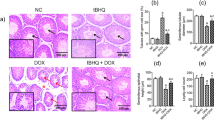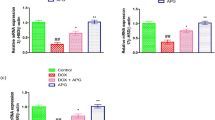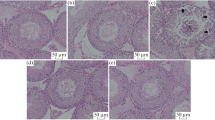Abstract
Doxorubicin (DOX) can be applied to treat several cancers. DOX-induced oxidative stress causes testicular damage. Diosmin (DIO), as a potent antioxidant, reduces many drugs' side effects. We determined DIO therapeutic effects on DOX-related testicular toxicity. Forty rats were assigned to five groups as control, DOX (2.5 mg/kg six i.p. injections at equal intervals over two weeks), DOX + DIO (25, 50, 100 mg/kg, orally, daily, for two weeks) groups. Oxidative and antioxidant markers, fertility parameters levels, sperm parameters, and a histopathological examination were analyzed. DOX group showed a significant decrease in the number of spermatogonia, primary spermatocytes, and sertoli cells, seminiferous tubular diameter, seminiferous luminal diameter, and seminiferous epithelial height. Moreover, testosterone levels, glutathione (GSH) levels, catalase (CAT), glutathione peroxidase (GPx), and superoxide dismutase (SOD) activities showed a significant decrease. Furthermore, nitric oxide (NO) and malondialdehyde (MDA) contents and also follicle-stimulating hormone (FSH) and luteinizing hormone (LH) levels showed a significant increase in the DOX group compared to the control group. DIO improved DOX-related alterations in levels of hormones, spermatogonia, spermatocytes, and sertoli cell number, and seminiferous diameters (tubular, luminal, and epithelial height). Furthermore, GSH level, SOD, GPx, and CAT activities showed a significant increase, and MDA and NO contents showed a significant decrease in the DOX + DIO group than the DOX group. The results indicate that DIO mitigate DOX‐induced testicular toxicity by its anti-oxidant activity.




Similar content being viewed by others
Data availability
The data generated and analyzed during the current study are available from the corresponding author upon reasonable request.
References
Abdelaziz MH, Salah El-Din EY, El-Dakdoky MH, Ahmed TA (2019) The impact of mesenchymal stem cells on doxorubicin-induced testicular toxicity and progeny outcome of male prepubertal rats. Birth Defects Res 111:906–919
Aksu EH, Kandemir FM, Yıldırım S, Küçükler S, Dörtbudak MB, Çağlayan C, Benzer F (2019) Palliative effect of curcumin on doxorubicin-induced testicular damage in male rats. J Biochem Mol Toxicol 33:e22384
Alafifi SA, Wahdan SA, Elhemiely AA, Elsherbiny DA, Azab SS (2023) Modulatory effect of liraglutide on doxorubicin-induced testicular toxicity and behavioral abnormalities in rats: role of testicular-brain axis. Naunyn-Schmiedeberg’s Arch Pharmacol 396:2987–3005
Ali SS, Ahsan H, Zia MK, Siddiqui T, Khan FH (2020a) Understanding oxidants and antioxidants: classical team with new players. J Food Biochem 44:e13145
Ali TM, Abo-Salem OM, El Esawy BH, El Askary A (2020b) The potential protective effects of diosmin on streptozotocin-induced diabetic cardiomyopathy in rats. Am J Med Sci 359:32–41
Ali N et al (2021) Protective effect of diosmin against doxorubicin-induced nephrotoxicity. Saudi J Biol Sci 28:4375–4383
Andreadou I et al (2007) Acute doxorubicin cardiotoxicity is successfully treated with the phytochemical oleuropein through suppression of oxidative and nitrosative stress. J Mol Cell Cardiol 42:549–558
Anwar MM, Laila IMI (2022) Protective and restorative potency of diosmin natural flavonoid compound against tramadol-induced testicular damage and infertility in male rats. Nat Prod Res 37:847–851
Aslani BA, Ghobadi S (2016) Studies on oxidants and antioxidants with a brief glance at their relevance to the immune system. Life Sci 146:163–173
Bahar O, Eraslan G (2023) Investigation of the efficacy of diosmin against organ damage caused by bendiocarb in male Wistar albino rats. Environ Sci Pollut Res 30:55826–55845
Bahrami N, Goudarzi M, Hosseinzadeh A, Sabbagh S, Reiter RJ, Mehrzadi S (2018) Evaluating the protective effects of melatonin on di (2-ethylhexyl) phthalate-induced testicular injury in adult mice. Biomed Pharmacother 108:515–523
Bansal AK, Bilaspuri G (2011) Impacts of oxidative stress and antioxidants on semen functions. Vet Med Int 2011:686137
Belhan S, Özkaraca M, Özdek U, Kömüroğlu AU (2020) Protective role of chrysin on doxorubicin-induced oxidative stress and DNA damage in rat testes. Andrologia 52:e13747
Çeribaşı AO, Sakin F, Türk G, Sönmez M, Ateşşahin A (2012) Impact of ellagic acid on adriamycin-induced testicular histopathological lesions, apoptosis, lipid peroxidation and sperm damages. Exp Toxicol Pathol 64:717–724
Cha K-M et al (2018) Korean red ginseng attenuates doxorubicin-induced testicular dysfunction in rats by modulating inflammatory, oxidative, and autophagy responses. J Funct Foods 40:736–743
Chainy G, Samantaray S, Samanta L (1997) Testosterone-induced changes in testicular antioxidant system. Andrologia 29:343–349
Collodel G, Moretti E, Micheli L, Menchiari A, Moltoni L, Cerretani D (2015) Semen characteristics and malondialdehyde levels in men with different reproductive problems. Andrology 3:280–286
Crespo M, Galvez J, Cruz T, Ocete M, Zarzuelo A (1999) Anti-inflammatory activity of diosmin and hesperidin in rat colitis induced by TNBS. Planta Med 65:651–653
Elhelaly AE et al (2019) Protective effects of hesperidin and diosmin against acrylamide-induced liver, kidney, and brain oxidative damage in rats. Environ Sci Pollut Res 26:35151–35162
Ellman GL (1959) Tissue sulfhydryl groups. Arch Biochem Biophys 82:70–77
El-Maddawy ZK (2019) Protective effects of zinc oxide nanoparticles against doxorubicin induced testicular toxicity and DNA damage in male rats. Toxicol Res 8:654–662
El-Sheikh AA, Morsy MA, Mahmoud MM, Rifaai RA (2014) Protective mechanisms of coenzyme-Q10 may involve up-regulation of testicular P-glycoprotein in doxorubicin-induced toxicity. Environ Toxicol Pharmacol 37:772–781
Goudarzi M, Haghi Karamallah M, Malayeri A, Kalantar M, Mansouri E, Kalantar H (2020) Protective effect of alpha-lipoic acid on di-(2-ethylhexyl) phthalate-induced testicular toxicity in mice. Environ Sci Pollut Res 27:13670–13678
Goudarzi M, Kalantar M, Sadeghi E, Karamallah MH, Kalantar H (2021) Protective effects of apigenin on altered lipid peroxidation, inflammation, and antioxidant factors in methotrexate-induced hepatotoxicity. Naunyn-Schmiedeberg’s Arch Pharmacol 394:523–531
Gurel C, Kuscu GC, Buhur A, Dagdeviren M, Oltulu F, Karabay Yavasoglu NU, Yavasoglu A (2019) Fluvastatin attenuates doxorubicin-induced testicular toxicity in rats by reducing oxidative stress and regulating the blood–testis barrier via mTOR signaling pathway. Hum Exp Toxicol 38:1329–1343
Hammond JB, Kruger NJ (1988) The bradford method for protein quantitation. New protein techniques 1988:25–32
Haybar H, Goudarzi M, Mehrzadi S, Aminzadeh A, Khodayar MJ, Kalantar M, Fatemi I (2019) Effect of gemfibrozil on cardiotoxicity induced by doxorubicin in male experimental rats. Biomed Pharmacother 109:530–535
Huyut Z, Alp HH, Yaman T, Keleş ÖF, Yener Z, Türkan F, Ayengin K (2021) Comparison of the protective effects of curcumin and caffeic acid phenethyl ester against doxorubicin-induced testicular toxicity. Andrologia 53:e13919
Ijaz MU et al (2022a) In vivo antioxidant efficacy and therapeutic potential of Artemisia brevifolia leaves extract against CCl4-induced reproductive damages in male albino rats. J King Saud Univ-Sci 34:101816
Ijaz MU et al (2022b) Pachypodol attenuates Perfluorooctane sulphonate-induced testicular damage by reducing oxidative stress. Saudi J Biol Sci 29:1380–1385
Jana K, Jana S, Samanta PK (2006) Effects of chronic exposure to sodium arsenite on hypothalamo-pituitary-testicular activities in adult rats: possible an estrogenic mode of action. Reprod Biol Endocrinol 4:1–13
Karimi A et al (2017) Evaluation of lithium serum level in multiple sclerosis patients: a neuroprotective element. Multiple Scler Relat Disord 17:244–248
Maksimović Ž, Maksimović M, Jadranin D, Kuzmanović I, Andonović O (2008) Medicamentous treatment of chronic venous insufficiency using semisynthetic diosmin: a prospective study. Acta Chir Iugosl 55:53–59
Mehrabani M, Goudarzi M, Mehrzadi S, Siahpoosh A, Mohammadi M, Khalili H, Malayeri A (2020) Crocin: a protective natural antioxidant against pulmonary fibrosis induced by bleomycin. Pharmacol Reports 72:992–1001
Mustafa S, Ijaz MU, ul Ain Q, Afsar T, Almajwal A, Shafique H, Razak S (2022) Isorhamnetin: a flavonoid, attenuated doxorubicin-induced testicular injury via regulation of steroidogenic enzymes and apoptotic signaling gene expression in male rats. Toxicol Res 11:475–485
Nasr AY (2017) The impact of aged garlic extract on adriamycin-induced testicular changes in adult male Wistar rats. Acta Histochem 119:648–662
Nimse SB, Pal D (2015) Free radicals, natural antioxidants, and their reaction mechanisms. RSC Adv 5:27986–28006
Öztürk E, Kaymak E, Akin A, Karabulut D, Ünsal HM, Yakan B (2020) Thymoquinone is a protective agent that reduces the negative effects of doxorubicin in rat testis. Hum Exp Toxicol 39:1364–1373
Prahalathan C, Selvakumar E, Varalakshmi P (2005) Protective effect of lipoic acid on adriamycin-induced testicular toxicity. Clin Chim Acta 360:160–166
Prahalathan C, Selvakumar E, Varalakshmi P (2006a) Lipoic acid modulates adriamycin-induced testicular toxicity. Reprod Toxicol 21:54–59
Prahalathan C, Selvakumar E, Varalakshmi P (2006b) Modulatory role of lipoic acid on adriamycin-induced testicular injury. Chem Biol Interact 160:108–114
Rehman MU et al (2013) Diosmin protects against trichloroethylene-induced renal injury in Wistar rats: plausible role of p53, Bax and caspases. Br J Nutr 110:699–710
Samad A et al (2020) Methanolic extract of Nepeta paulsenii as an ameliorative agent against CCl4 induced testicular damage in male albino rats. J King Saud Univ-Sci 32:1168–1174
Shamsi M et al (2010) Antioxidant levels in blood and seminal plasma and their impact on sperm parameters in infertile men. Indian J Biochem Biophys 47:38–43
Silambarasan T, Raja B (2012) Diosmin, a bioflavonoid reverses alterations in blood pressure, nitric oxide, lipid peroxides and antioxidant status in DOCA-salt induced hypertensive rats. Eur J Pharmacol 679:81–89
Silva RC, Britto DMC, de Fátima PW, Brito-Melo GEA, Machado CT, Pedreira MM (2018) Effect of short-and medium-term toxicity of doxorubicin on spermatogenesis in adult Wistar rats. Reprod Biol 18:169–176
Tanigaki R et al (2013) C-kit expression in spermatogonia damaged by doxorubicin exposure in mice. J Obstet Gynaecol Res 39:692–700
Tekeli MY, Eraslan G, Çakır Bayram L, Soyer Sarıca Z (2021) Effect of diosmin on lipid peoxidation and organ damage against subacute deltamethrin exposure in rats. Environ Sci Pollut Res 28:15890–15908
Yokochi T, Robertson KD (2004) Doxorubicin inhibits DNMT1, resulting in conditional apoptosis. Mol Pharmacol 66:1415–1420
Funding
This study is delivered from a Pharm. D. Thesis of Shahin Moradi and was financially supported by the Medicinal Plant Research Center (Grant number: MPRC-0006), funded by the Vice Chancellor of Research, Ahvaz Jundishapur University of Medical Sciences, Ahvaz, Iran.T
Author information
Authors and Affiliations
Contributions
ARM: Supervision, Funding acquisition, Conceptualization, Writing - Original Draft, SMB: Investigation, Project administration, ZB: Formal analysis, Conceptualization, HK: Formal analysis, Methodology, Writing - Review & Editing, Conceptualization. The authors declare that all data were generated in-house and that no paper mill was used.
Corresponding author
Ethics declarations
Ethical approval
This research was conducted according to the instructions of the Animal Ethics Committee of Ahvaz Jundishapur University of Medical Sciences for the use and care of laboratory animals (IR.AJUMS.ABHC.REC.1400.031).
Consent to participate
Not applicable.
Consent for publication
The authors confirm their consent for publication.
Competing interests
The authors declares no competing interests.
Additional information
Publisher's Note
Springer Nature remains neutral with regard to jurisdictional claims in published maps and institutional affiliations.
Rights and permissions
Springer Nature or its licensor (e.g. a society or other partner) holds exclusive rights to this article under a publishing agreement with the author(s) or other rightsholder(s); author self-archiving of the accepted manuscript version of this article is solely governed by the terms of such publishing agreement and applicable law.
About this article
Cite this article
Malayeri, A., Birgani, S.M., Basir, Z. et al. Protective effects of diosmin on doxorubicin-induced testicular toxicity in rat. Naunyn-Schmiedeberg's Arch Pharmacol (2024). https://doi.org/10.1007/s00210-024-03134-3
Received:
Accepted:
Published:
DOI: https://doi.org/10.1007/s00210-024-03134-3




